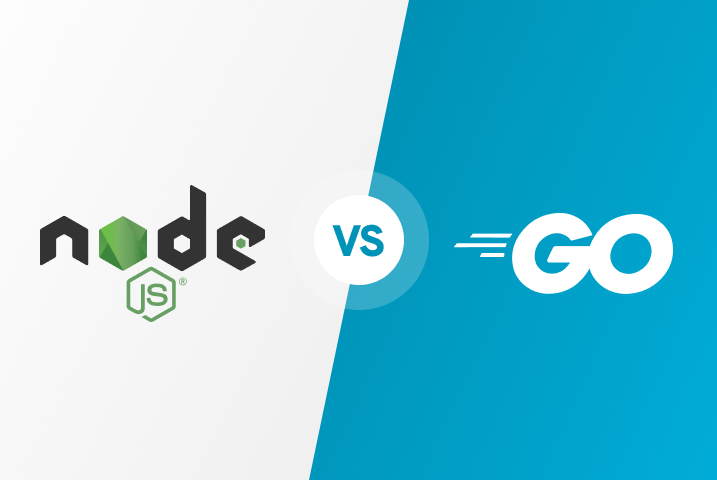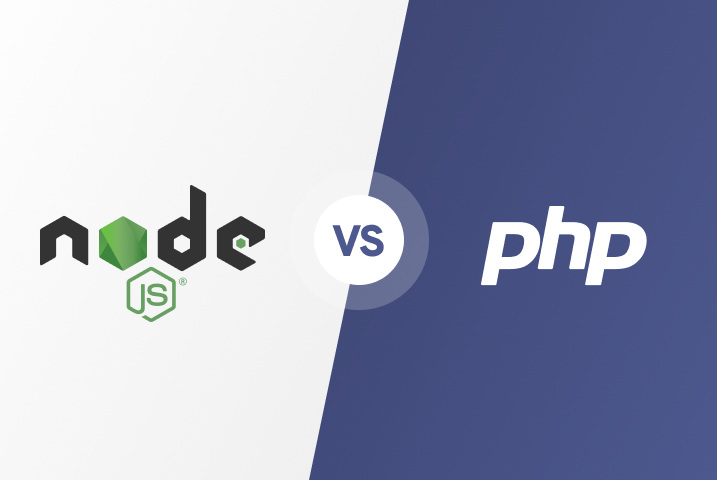Web DevelopmentCTO Insights: GO vs Node JS


Marcin Sadowski
CTO @ JS and Web3 Expert

Oskar Skowroński
Backend and NodeJS Developer
Table of contents
Share the article
Introduction
The source of programming language and javascript runtime environment is pivotal in determining the efficiency and overall performance of modern web applications and scalable server-side systems. Among the myriad options available, Node.js has emerged as an industry leader, captivating developers with distinct approaches and philosophies.
NodeJS, an open-source, cross-platform runtime environment, empowers developers to execute JavaScript code outside the confines of web browsers. Leveraging the robust V8 JavaScript engine and an event-driven, non-blocking I/O model, Node.js offers a lightweight and highly efficient solution for handling concurrent connections.
On the other hand, Go, commonly called Golang, is a compiled single programming language meticulously crafted by Google. Designed to address the complexities of large-scale software web app development, Go blends high-level languages' simplicity and readability with the performance and low-level control typically related to popular programming languages. Its approach to concurrency and parallelism has garnered widespread acclaim, making it an ideal choice for distributed systems, network servers, and various types of system software.
As the demand for high-performance, scalable, and reliable apps intensifies, Node.js and Go become increasingly pertinent. This comprehensive article delves deep into the intricacies of these powerful backend technologies, offering an in-depth analysis of their strengths, weaknesses, and suitability across diverse use cases.
What is Node JS?
Node.js is an open-source, cross-platform that allows developers to execute JavaScript code outside a web browser. It is built on the V8 JavaScript engine, the same engine used by Google Chrome. It utilizes an event-driven, non-blocking I/O model, making it lightweight and efficient for handling concurrent connections. Node.js is primarily used for building high-performance, scalable network applications, such as web servers, real-time applications, and APIs.
Moreover, Node.js's cross-platform empowers developers to write code that can run seamlessly across various operating systems, including Windows, macOS, and Linux.
This flexibility, combined with its thriving community and rich ecosystem of modules and libraries, has propelled Node.js to the front end of modern application development, making it an indispensable tool in the arsenal of forward-thinking availability of developers worldwide.
What is the Go language?
Go, also known as Golang, is a statically typed, compiled programming language designed by Google. It was created to address the challenges faced by large-scale software development, such as concurrency, scalability, and efficiency.
Go combines the simplicity and readability of high-level other programming languages with the performance and low-level control typically associated with systems programming languages like C and C++. It is widely used for building distributed systems, network servers, and various types of system software.
Go's innovative approach to concurrency, through the use of lightweight threads called goroutines and channels for communication, has garnered widespread acclaim, enabling Golang developers to craft highly concurrent and efficient applications with ease.
Pros and Cons of Golang

Pros of Golang
Golang offers several advantages that make it a compelling preferred choice for developers:
Simplicity and Readability: Go's syntax is clean and straightforward, making it easy to read and maintain code. It favors simplicity over excessive features, which can lead to reduced stack development time and improved productivity.
Concurrency and Parallelism: Go provides built-in support for concurrency and parallelism through its lightweight goroutines and channels. This makes it well-suited for developing highly concurrent and efficient applications, particularly in distributed systems and network programming.
Performance and Efficiency: Go produces highly optimized and efficient machine code as a compiled language, resulting in excellent performance characteristics. It also has a built-in garbage collector, reducing the need for manual memory management.
Cross-Platform: Go code can be compiled and run on multiple platforms, including Windows, macOS, Linux, and others, without extensive modifications or platform-specific code.
Cons of Golang
However, Go also has its limitations and drawbacks:
Lack of Generics: While Go supports type inference, it lacks support for generics, which can lead to code duplication and increased complexity in specific scenarios.
Smaller Ecosystem and Libraries: Compared to more established languages, Go's ecosystem and available libraries are relatively more minor, although rapidly growing.
Steep Learning Curve: While Go's syntax is simple, its unique approach to concurrency and other paradigms may require a steeper learning curve for developers from traditional object-oriented or functional programming backgrounds.
Pros and Cons of Node.js

Pros of Node.Js
Node.js has gained significant popularity in recent years due to its ability to handle concurrent connections efficiently and its extensive ecosystem of packages and libraries. Here are some of the key pros and cons of Node.js:
Event-Driven and Non-Blocking I/O: Node.js follows an event-driven, non-blocking I/O model, making it highly efficient for handling concurrent connections and real-time applications.
Cross-Platform: Node.js is cross-platform, allowing developers to write code that can run on various operating systems, including Windows, macOS, and Linux.
Large and Active Ecosystem: Node.js boasts a vast and active ecosystem of open-source packages and libraries, thanks to its widespread adoption and the JavaScript community's contributions.
Fast Development Cycle: With its lightweight and flexible nature, Node.js allows for rapid tech stack development and iteration, enabling developers to build and deploy applications quickly.
Cons of Node.js
However, Node.js also has its limitations and drawbacks:
Single-Threaded Execution: Node.js is single-threaded, which means it can handle concurrent operations efficiently, but intensive tasks can block the event loop, leading to performance issues.
Callback Hell and Asynchronous Code: Managing asynchronous code in Node.js can be challenging, especially when dealing with deeply nested callbacks or complex control flows, a phenomenon known as "callback hell."
Memory Leaks and Resource Management: While Node.js provides automatic memory management, developers must be cautious about potential memory leaks and proper resource management, as Node.js applications can consume significant system resources if not managed properly.
Horizontal Scaling Challenges: While Node.js excels at vertical scaling (scaling up resources on a single machine), horizontal scaling (scaling across multiple machines) can be more complex and may require additional tooling.
Comparison of NodeJS vs Golang
The detailed comparison of Node js vs. Golang is given below:
Performance
Node.js and Go are known for their performance abilities, but they achieve it through key differences and various approaches.
Node.js leverages an event-driven, non-blocking I/O model, which makes it highly efficient for handling concurrent connections and network-bound operations. However, Node.js can suffer from performance bottlenecks for intensive tasks or CPU-bound operations due to its single-threaded nature.
On the other hand, Go is designed with performance as a core principle. Go produces highly optimized machine code as a compiled language, resulting in excellent runtime performance.
Go's built-in support for concurrency through goroutines and channels allows for efficient handling of CPU- and I/O-bound workloads.
In general, Go tends to outperform Node.js in intensive tasks and scenarios requiring high concurrency and parallelism levels. However, for I/O-bound operations and handling a large number of concurrent connections, Node.js can be a more suitable choice.
Error Handling
Error handling is a crucial aspect of any programming language or runtime environment, and both Node.js and Go provide mechanisms for handling errors effectively.
In Node.js, errors are typically handled through callbacks or promises. Developers can use try-catch blocks to handle synchronous errors and attach error handlers to asynchronous operations.
However, managing error handling in large and complex codebases can become challenging, especially when dealing with nested callbacks or complex control flows.
Go, on the other hand, takes a more explicit and structured approach to error handling. Go encourages developers to treat errors as values and propagate them through the code rather than relying on exceptions or try-catch blocks.
This approach makes it easier to reason about error handling and ensures that errors are handled consistently throughout the codebase.
While both languages provide mechanisms for error handling, Go's approach is generally considered more robust and easier to manage, especially in large-scale projects.
Concurrency Model
Concurrency is a critical aspect of modern software development, and both Node.js and Go offer different models for handling concurrent operations.
Node.js follows an event-driven, non-blocking I/O model, allowing it to handle many concurrent connections efficiently. However, Node.js is single-threaded, which means intensive tasks can block the event loop, leading to performance issues.
To mitigate this, Node.js developers often rely on worker threads or child processes to offload CPU-intensive tasks.
Go, on the other hand, has built-in support for concurrency through goroutines and channels. Goroutines are lightweight threads that share the same address space, allowing for efficient communication through channels.
This model enables Go to handle I/O-bound and CPU-bound workloads concurrently without complex thread management or synchronization primitives.
Go's concurrency model is often praised for its simplicity and efficiency, making it well-suited for developing highly concurrent and distributed systems. However, it does come with a learning curve, as developers need to understand the concepts of goroutines and channels to fully leverage Go's concurrency abilities.
Deployment and Cross-Platform Support
Both Node.js and Go offer cross-platform support, allowing developers to build applications running on various operating systems and environments.
Node.js is a runtime environment that relies on the underlying operating system for execution. It provides a consistent runtime environment across different platforms, enabling developers to write code that can run on Windows, macOS, Linux, and other operating systems with minimal modifications.
Go, on the other hand, is a compiled language that produces platform-specific binaries. These binaries can be deployed and executed directly on the target platform without additional runtime environments or dependencies.
This makes Go applications highly portable and easy to distribute, as they can run standalone without requiring additional installations.
Ecosystem and Libraries
The ecosystem and access to libraries and packages are essential for development, boosting productivity, and preventing duplication of work. Node.js has a thriving ecosystem thanks to its popularity and the involvement of the JavaScript community. These packages cover a wide range of web frameworks, databases, utilities, and testing tools, providing developers with rich resources to build their applications.
In contrast, Go's ecosystem is relatively more minor but overgrowing. The Go community has developed several package managers, such as the official Go modules system and third-party tools like Dep and Glide.
While the number of available packages and libraries is not as extensive as Node.js, Go's ecosystem still offers various packages for various domains, including web development, networking, cryptography, and data processing.
Additionally, Go's focus on simplicity and minimalism can lead to smaller, more manageable codebases, potentially offsetting the need for a larger ecosystem.
Learning Curve
The learning curve associated with Go and Node.js can significantly impact developer productivity and adoption. Node.js, based on JavaScript, has a relatively low learning curve for developers familiar with web development. However, as applications become complex, developers must grasp concepts like asynchronous programming and modularization. Conversely, Go presents a steeper learning curve, especially for those from traditional object-oriented backgrounds. Its unique approach to concurrency, error handling, and strong typing requires adjustments. While Go's simplicity can lead to long-term productivity gains, the initial investment in learning the language may be higher than Node.js's more gradual learning path for JavaScript developers. Ultimately, the trade-off lies between Node.js and the potential benefits of Go's robustness and performance for specific use cases.
Scalability and concurrency
Scalability and concurrency are critical factors in modern software development. Go's innovative concurrency model, leveraging lightweight goroutines and channels, allows for efficient handling of CPU-bound and I/O-bound workloads concurrently, making it well-suited for building highly concurrent and distributed systems.
Node.js with its event-driven, non-blocking I/O model, Node.js excels at handling numerous concurrent connections and I/O operations, which is ideal for scalable web applications and real-time systems. However, Node.js may require additional techniques like worker threads or clustering for CPU-intensive tasks. Go's built-in concurrency primitives provide a more straightforward approach, while Node.js offers flexibility in its asynchronous programming model.
Difficulty Level for backend development
The difficulty level and learning curve associated with a programming language or runtime environment can significantly impact developer productivity and adoption.
Node.js, based on JavaScript, has a relatively low learning curve for developers already familiar with backend web development and JavaScript. The language's syntax and concepts are widely known, and the ability to use JavaScript for both front-end and back-end development can provide a seamless development experience.
However, as Node.js applications grow in complexity, developers may need to learn additional concepts and patterns, such as asynchronous programming, event handling, and modularization.
On the other hand, Go has a steeper learning curve, particularly for developers from traditional object-oriented or functional programming backgrounds. While Go's syntax is relatively simple, its unique approach to concurrency, error handling, and other paradigms can be challenging to grasp initially. Additionally, Go's strong typing and compilation requirements may require adjustments for developers accustomed to dynamically typing other languages.
However, once developers overcome the initial learning curve, Go's simplicity, consistency, and built-in support for concurrency can lead to increased productivity and more robust code in the long run. The trade-off lies between the initial investment in learning Go and its potential benefits for specific applications and system software development.
Do you need support with your NodeJS backend development efforts?

Or contact us:
Future Trends and Adoption
Node.js has firmly established itself as a leading runtime environment for building server-side applications, particularly in web development, real-time applications, and APIs. Its widespread adoption, large ecosystem, and the increasing demand for JavaScript skills continue to drive its growth. Additionally, the rise of serverless computing and cloud-native architectures has further boosted Node.js's adoption, as its lightweight and event-driven nature aligns well with these paradigms.
On the other hand, Go has gained traction in system programming, distributed systems, and cloud-native applications. Its performance, concurrency model, and cross-platform frontend capabilities have made it attractive for building scalable and efficient backend tools, microservices architectures, and infrastructure software.
Go's adoption has been robust in cloud computing and DevOps domains, where companies and apps like Google, Kubernetes, Docker, and others have embraced Go for their projects.
Looking ahead, both Node.js and Go are expected to continue growing in popularity and adoption, driven by their respective strengths and the evolving demands of the software industry. Node.js is likely to maintain its dominance in web development and real-time applications. At the same time, Go's adoption may continue to rise in areas such as cloud computing, distributed systems, and systems programming.
Conclusion
In the ever-evolving landscape of software development, Node.js and others have emerged as powerful contenders, each offering unique strengths and capabilities. The choice between these two technologies ultimately depends on the project's specific requirements, the development team's skillset, and the priorities of performance, concurrency, and ecosystem considerations.
For projects that demand high-performance network applications, real-time systems, or rapid prototyping, Node.js may be the more suitable choice, thanks to its extensive ecosystem and familiarity with JavaScript. On the other hand, Go's strengths lie in building highly concurrent and distributed systems, system software, and applications that require exceptional performance and efficient resource utilization.
Regardless of the chosen technology, both Node.js and Go continue to evolve, with active communities driving innovation and addressing emerging challenges in software development. As the demand for scalable, efficient, and reliable systems grows, adopting these technologies will likely continue, shaping the future of web development, cloud computing, and systems programming.
By leveraging the right tool for the job, developers can unlock new possibilities and create robust, performant, and scalable applications that meet the ever-increasing digital age demands.
Backend Development Insights
Dive into the web and backend development world with a focus on Node JS and Nest JS frameworks at Mobile Reality. We are thrilled to share our deep knowledge and practical insights into these robust technologies. Explore the unique challenges and cutting-edge solutions we encounter in backend development. Our expert team has curated a series of articles to provide you with a comprehensive understanding of backend development, NodeJS, and NestJS:
- Creating your own streaming app with WebRTC
- Advantages and disadvantages of NestJS
- Types of Apps You Can Build with Node JS in 2024
- Node JS vs PHP: A Complete Comparison for CTOs
- Pros & Cons of TypeScript In Web Development
- Top 5 Node.JS Backend Tools and Libraries
Gain a deeper understanding of these powerful backend technologies. If you want to collaborate on Node JS development projects, please contact our sales team for potential partnerships. For those looking to join our dynamic team, we encourage you to contact our recruitment department. We're always looking for talented individuals to enhance our backend development capabilities. Let's connect and explore how we can achieve great things together!
Did you like the article?Find out how we can help you.
Matt Sadowski
CEO of Mobile Reality

Related articles

26.04.2024
Top ReactJS Best Practices for Frontend Teams
Discover essential React JS Best Practices for Frontend Development Teams. Elevate your coding game with expert tips and techniques.
Read full article

26.04.2024
Node JS vs PHP: A Complete Comparison for CTOs
Discover the essential guide for CTOs comparing Node JS vs PHP. Make the right choice for your tech stack. Get insights now! #nodejs #php #CTO
Read full article

26.04.2024
Types of Apps You Can Build with Node JS in 2024
Read what types of applications you can build using Node JS technology.
Read full article